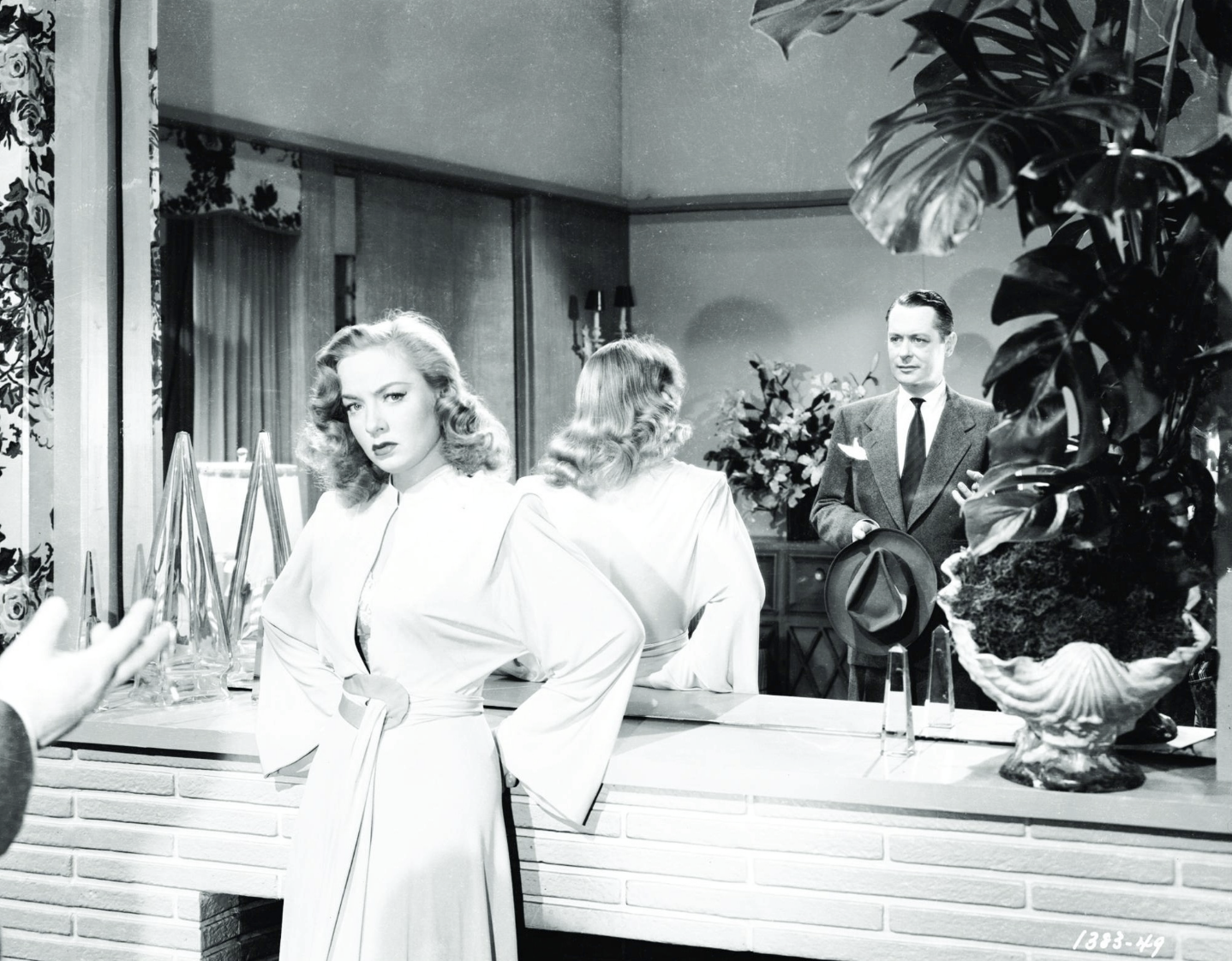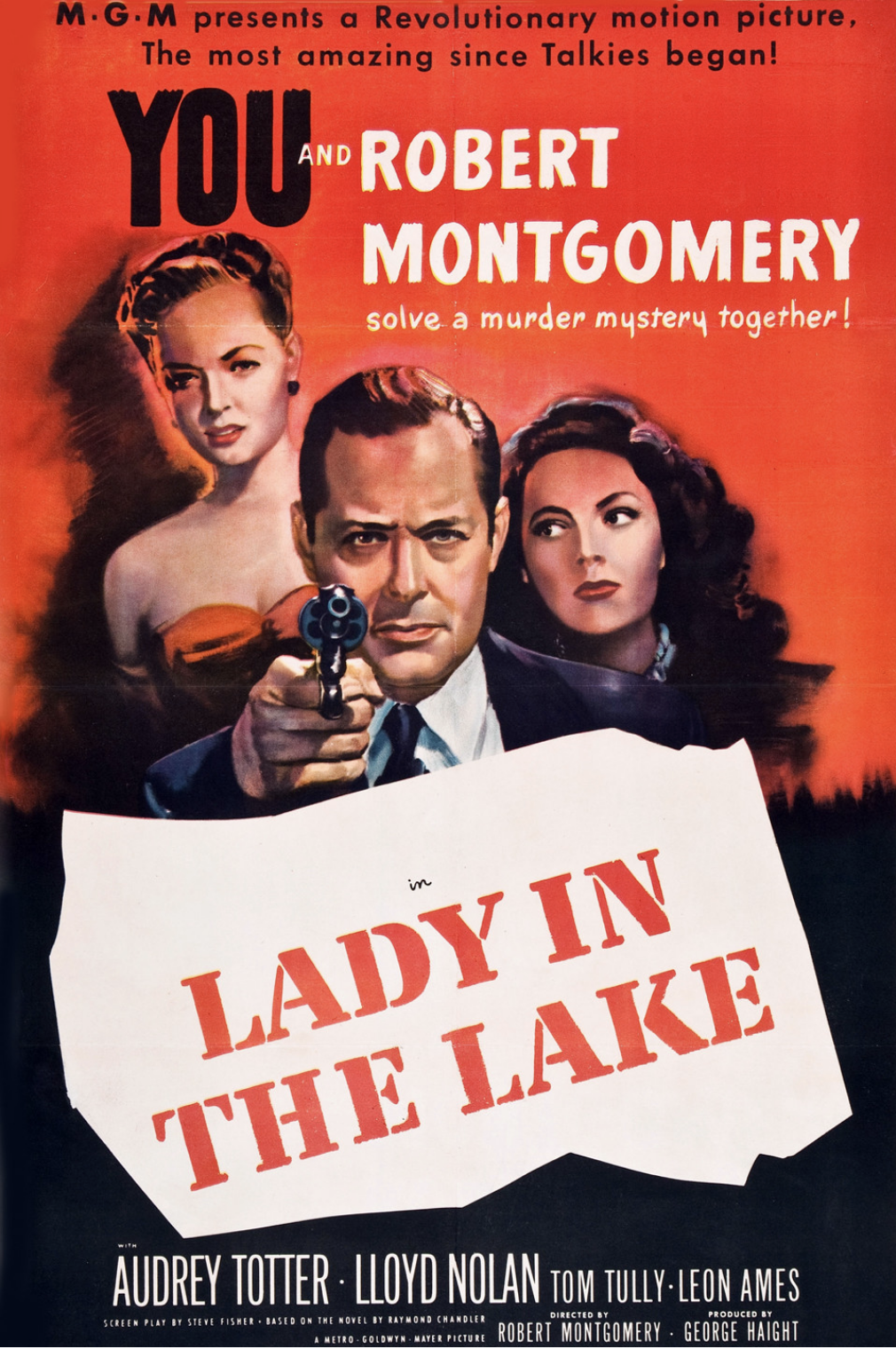Lady in the Lake: Distinctive Film Techniques Can Either Enhance or Obstruct
Robert Montgomery and Audrey Totter in Lady in the Lake (1946)
‘MGM presents a revolutionary motion picture. The most amazing since Talkies began! You and Robert Montgomery solve a murder mystery together!’
The 1947 movie ‘Lady in the Lake’ is based on the Raymond Chandler novel of the same name. In many ways it’s a typical film noir, following hard-boiled LA private detective Philip Marlowe as he navigates a world of murder, mystery and a missing woman. There are crooked cops, unreliable witnesses and an enchanting femme fatale; cynical double-crosses, brutal violence and a crisp, caustic script.
'My name is Marlowe, Philip Marlowe. Occupation: private detective. You know, somebody says, ‘Follow that guy’, so I follow him. Somebody says, ‘Find that female’, so I find her. And what do I get out of it? $10 a day and expenses. And if you think that buys a lot of fancy groceries these days, you're crazy.’
What distinguishes ‘Lady in the Lake’ is the decision of lead actor and first-time director Robert Montgomery to use point-of-view cinematography: the viewer experiences the entire drama from Marlowe’s perspective.
‘You’ll see it just as I saw it. You’ll meet the people. You’ll find the clues. And maybe you’ll solve it quick and maybe you won’t.’
The subjective camera tracks along corridors and up staircases. It looks to left and right to review the situation, and then focuses in on the key protagonists, who address us directly. We see a hand on the door handle as Marlowe enters a room; smoke billows before us as he lights a cigarette; and the leading lady even gives us a kiss. On a number of occasions we catch Marlowe’s reflection in the mirror. And when he is punched in the face, we tumble to the floor and everything goes woozy.
'Perhaps you'd better go home and play with your fingerprint collection.’
It was quite a challenge sustaining the point-of-view approach through the whole picture. To capture Marlowe’s walking movement the production team employed a new kind of dolly, with four independent wheels. A seat for Montgomery was attached at the front, so that the actors could respond to him. And for the fight scenes a camera with a flexible shoulder harness was used.
'I wonder how it would be to discuss this over a couple of ice cubes. Would you care to try?’
'Imagine you needing ice cubes.’
However, the production was problematic. Scenes planned for the lake of the title were cancelled because the technique proved difficult to execute outdoors. MGM studio bosses became frustrated that their expensive leading actor barely appeared on-screen, and insisted on the insertion of a number of awkward explanatory interludes where Marlowe reviews events afterwards in his office. They also demanded a happy ending.
‘Now what am I supposed to do? Reform? Become poor-but-honest? On what street corner would you like me to beat my tambourine?’
Watching the film today, initially the effect is intriguing. The characters seem to be addressing us personally. We feel involved in the action. We encounter the twists and turns of the plot as if we are detectives. We are Philip Marlowe!
But over the one hour and three quarters running time, the approach becomes a little wearing, somewhat artificial. It is as irritating as it is interesting.
'Please don't be so difficult to get along with. I need help.’
'Like I need four thumbs.'
Robert Montgomery, Audrey Totter in Lady in the Lake (1946)
In the course of my career in advertising we often developed commercials that employed a distinctive technique. We played scenes backwards, slowed them down, re-ordered them and mixed filmic styles. We explored original editing, unusual music, eccentric sound effects, and more besides.
Sometimes a fresh technique succeeded in prompting involvement; in drawing attention to the core idea. Sometimes it just got in the way. It was always a calculated risk.
Perhaps BBH’s most successful such experiment in my time there also involved point-of-view camerawork: Levi’s 1993 ad ‘Drugstore.’
We follow events from the perspective of a young man as he buys condoms from a general retailer and pops them in the watch-pocket of his 501s. He drives to his girlfriend’s house to take her on a date. When he knocks on her door, it is opened by the man who made the sale - her surprised, and concerned, father. The endline reads: 'Watch pocket created in 1873. Abused ever since. Levi’s 501. The Original Jean.’
What sets ‘Drugstore’ apart from other technique-based executions is the sheer quality of the filmmaking. Nick Worthington and John Gorse’s script had at its heart something of a Benny Hill gag. But they chose exceptional director Michel Gondry to shoot it with style and panache – with suggestions of ‘Grapes of Wrath’ and O Winston Link. And they selected a contemporary electronic soundtrack by Biosphere to give it an eerie, haunted quality. And to keep people on their toes, they also filmed a gender-switch version where the young woman buys the condoms.
In the midst of all this inventiveness the point-of-view camera technique enhances rather than obstructs the drama. And maybe that’s the lesson.
‘You stick your nose into my business and you’ll end up in an alley where the cat’s looking at you.’
So what became of ‘Lady in the Lake’?
Well, Chandler, whose own version of the script had been rejected, was unimpressed with the finished product and demanded that his name be removed from the credits. Critics were also largely underwhelmed. And Montgomery, who had been under contract with MGM since 1929, never made a film with them again.
Despite all this, the movie was a box-office success. And perhaps this was the biggest mystery of all.
'Put yourself in my place
If only for a day.
See if you can stand
The awful hurt I feel inside.
Put yourself in my place
For just a little while.
Live through the loneliness
The endless emptiness
I go through.
And when you lose a little sleep at night
Cause you ain't been treated right,
Then you know heartaches are sad.
Sitting by the telephone
Being left all alone,
Then you know why I'm feeling bad.
Put yourself in my place.’
The Elgins, 'Put Yourself in My Place’ (Holland–Dozier–Holland)
No. 442






